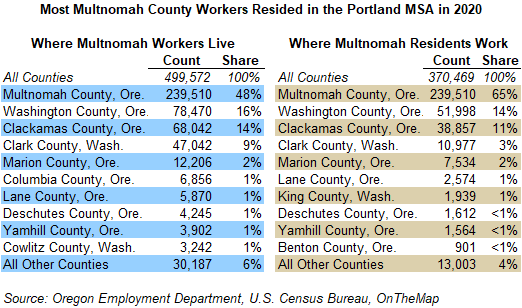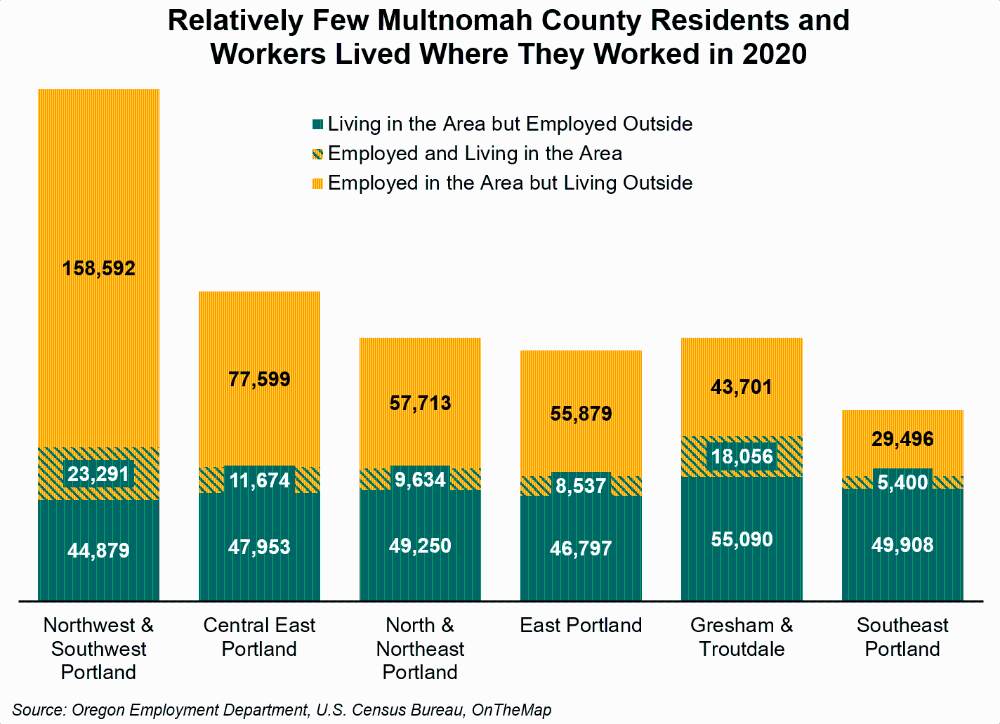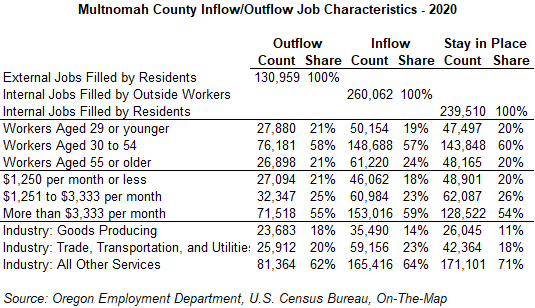Travel Patterns in Multnomah County – 2020
July 26, 2023One of the facts of living in an urban county like Multnomah County is that there is a lot of commuting. The U.S. Census Bureau provides data about commuting patterns with its OnTheMap tool. In 2020, about half of jobs located in Multnomah were filled by Multnomah residents, and about two-thirds of Multnomah residents worked at a job located in Multnomah. In other words, Multnomah is a jobs center for people commuting in, and many, though not all, residents of the area stay here to work.

The vast majority, 89%, of the 500,000 jobs located in Multnomah County were held by a resident of the seven-county Portland-Vancouver-Hillsboro Metropolitan Statistical Area (Portland MSA) in 2020. Looking at specific counties in the Portland MSA, 239,500 (48%) of all Multnomah jobs were held by Multnomah residents in 2020. For the rest of the Portland MSA counties, Washington County residents held 78,500 (16%) of the Multnomah jobs; Clackamas, 68,000 (14%); Clark, Wash., 47,000 (9%); Columbia, 6,900 (1%); Yamhill, 3,900 (1%); and Skamania, Wash., 800 (<1%). Residents of counties outside the MSA held the remaining 11% of Multnomah County jobs (55,800) led by Marion, 12,200 (2%); Lane, 5,900 (1%); Deschutes, 4,200 (1%); and Cowlitz 3,200 (Wash., 1%).
On the flip side, of the 370,500 jobs held by a resident of Multnomah, 93% were located in the Portland MSA. Again, most of those jobs, 239,500 (65%), were in Multnomah. A considerable number of Multnomah residents work in the other Portland MSA counties: in Washington County, 52,000 jobs are held by Multnomah residents (14% of total jobs held by Multnomah residents); Clackamas, 38,900 (11%); Clark, Wash., 11,000 (3%); Yamhill, 1,600 (<1%); Columbia, 700 (<1%); and Skamania, Wash., 100 (<1%). Non-Portland MSA counties where a substantial share of Multnomah residents worked include Marion with 7,500 (2% of total jobs held by Multnomah residents); Lane, 2,600 (1%); King, 1,900 (Wash., 1%); Deschutes, 1,600 (<1%); and Benton, 900 (<1%).
Most Multnomah Residents and Laborers Work Outside Their Neighborhood
Looking specifically at different regions within Multnomah County, a pattern starts to emerge. While most Multnomah residents work in Multnomah, it is not necessarily in the neighborhood where they live. Only about 15% of jobs located in Multnomah County were held by someone who lives in the same region of the county. This ranges from a low of 10% of Southeast Portland residents working where they live to a high of 34% in Northwest & Southwest Portland.

There are a few potential reasons why such a small share of people in Multnomah work where they live. First, many workers commute into the downtown core from suburbs surrounding Portland and Multnomah. Workers may prefer to live in a neighborhood that has less population density than central Portland, or they may not be able to afford living near their workplaces. Additionally, the commercial density (and relatively sparse housing) of Portland’s downtown core necessitates that workers flow in from elsewhere.
In-Commuters to Multnomah County Tend to Be Older and Have Higher Incomes
Typical of large urban counties, substantially more Multnomah residents work within the county (239,510) than outside the county (130,959). Other differences of note among commuting characteristics include that out-commuters are more likely to work in goods-producing industries. Goods-producing industries include natural resources, construction, and manufacturing. In-commuters to Multnomah tend to be slightly older and are more likely to earn more than $3,333 monthly than workers who live in Multnomah. Workers who stay in place are more likely to work in all other services than workers who commute into or out of the county. All other services include the sectors of information, professional and business services, education and health services, and leisure and hospitality.

Commutes Differs By Occupation
While On-The-Map is a powerful tool to evaluate local labor sheds, its data doesn’t tell us how commutes occurred or how long commuters stayed for work. Several scenarios are possible and likely. Commuters can be full or partial telecommuters, working for a firm outside their county of residence and infrequently making a physical commute. Home-based call center employees and outside sales representatives are examples of occupations that fit this scenario. Commuters can commute for extended shifts, short stays, or even seasons, traveling to where the job demand is and returning home when the work is complete. Nurses and physicians are examples of extended shift or short stay occupations. Commuters with either of these occupations could work for a two- or three-day shift and then return home for three or four days. Construction workers on special projects and certain agriculture workers are examples of seasonal positions that require extended stays, but might not encourage year-round residence.